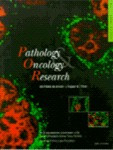Vicha A, Holzerova M, Krepelova A, Musil Z, Prochazka P, Sumerauer D, Kodet R, Eckschlager T, Jarosova M. Pathol Oncol Res. 2011 Dec;17(4):801–8. Epub 2011 Apr 5. IF: 1.483

Department of Paediatric Haematology and Oncology
Abstract:
Pheochromocytomas (PCCs) are rare tumors among children and adolescents and therefore are not genetically well characterized. The most frequently observed chromosomal changes in PCC are losses of 1p, 3q and/or 3p, 6q, 17p, 11q, 22q, and gains of 9q and 17q. Aberrations involving chromosome 11 are more common in malignant tumors. Unfortunately information about gene aberrations in childhood PCC's is limited. We used comparative genomic hybridization (CGH) and array comparative genomic hybridization (aCGH) to screen for copy number changes in four children suffering from pheochromocytoma or paraganglioma. Patients were diagnosed at the age 13 or 14 years. Bilateral pheochromocytoma was associated with von Hippel-Lindau syndrome (VHL). Multiple paraganglioma was associated with a germline mutation in SDHB. We found very good concordance between the results of CGH and aCGH techniques. Losses were observed more frequently than gains. All cases had a loss of chromosome 11 or 11p. Other aberrations were loss of chromosome 3 and 11 in sporadic pheochromocytoma, and loss of 3p and 11p in pheochromocytoma, which carried the VHL mutation. The deletion of chromosome 1p and other changes were observed in paragangliomas. We conclude that both array CGH and aCGH analysis identified similar chromosomal regions involved in tumorigenesis of pheochromocytoma andparagangliomas, but we found 3 discrepancies between the methods. We didn't find any, of the proposed, molecular markers of malignancy in our benign cases and therefore we speculate that molecular cytogenetic examination may be helpful in separating benign and malignant forms in the future.